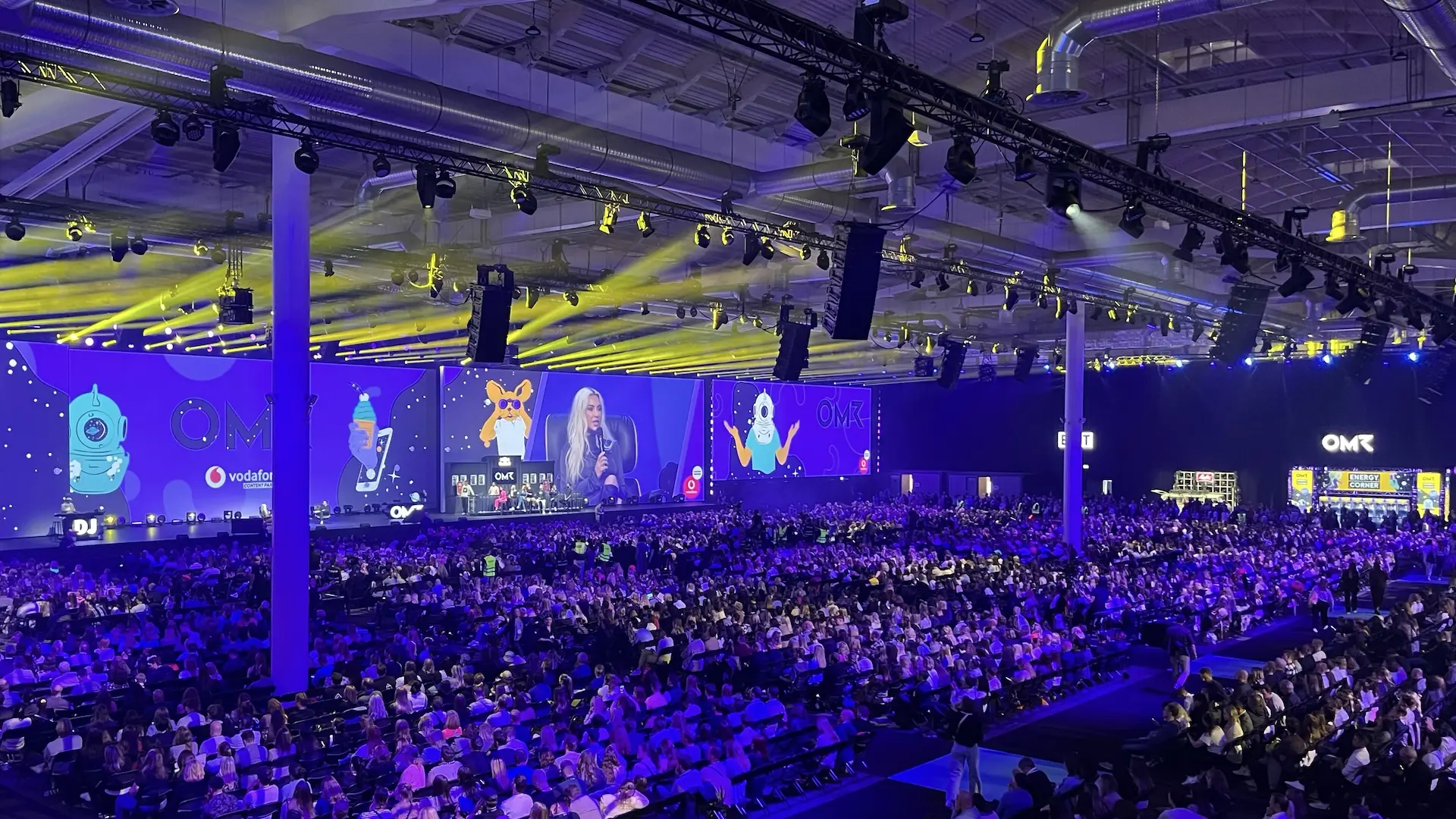I want to start with a disclaimer: I’ve been working at OMR since mid-January 2024 as a software developer. Many people know about the OMR Festival, but OMR is a company with various sub-companies like Podstars, OMR Education, OMR Jobs & HR, and OMR Reviews. I work at OMR Reviews, which is a review platform for SaaS products. My team attended the festival, like all the other companies, to showcase our product and connect with potential customers. So, while I may not be completely unbiased, I’ll try to provide an honest review of the festival. This article is not sponsored or reviewed by OMR.
What is the OMR Festival?
The OMR Festival is a two-day marketing event held in Hamburg, Germany. It’s one of Europe’s largest marketing events, drawing thousands of visitors each year since its establishment in 2011. In 2023, over 70,000 people attended. I’ve never experienced a festival like this before, so I’d like to paint a picture of what it’s like before sharing my thoughts.
The festival is held at the Hamburg Messe, a vast exhibition center (100.000 sqm) in the heart of Hamburg. It’s so large that without the accompanying app featuring a map, you could easily get lost. The app helps navigate the different areas, including 6 stages, exhibitors, and food stands. The festival is divided into three main parts: the Expo, the Masterclasses, and the Conference. The Expo, the largest section, features more than 1.000 of exhibitors from around the world, ranging from major companies like Google, Meta, and Amazon to small startups and agencies. The Masterclasses offer smaller workshops focusing on specific topics such as SEO, social media marketing, or influencer marketing. The Conference is the primary stage for keynotes and panel discussions. Additionally, the festival provides networking opportunities, parties, and after-show events.
First day
I got to the festival bright and early on the first day, around 8 am. Thanks to my purple crew badge, I could get in before the official 9 am opening. I headed straight to the OMR Reviews booth to help my team set up and distribute badges to the exhibitors on our platform. After that, I wandered around the Expo, checking out various interesting booths. I grabbed a quick breakfast at the crew catering area before continuing to explore the festival.

I’ve been to the Hamburg Messe before for the Affordable Art Fair, but this time the festival occupied the entire venue. They even closed down Karolinenstraße, which usually divides the Messe, to connect both areas. A few days prior to the festival, I had already picked out the conferences I wanted to attend and marked them in the app. The first one on my list was Scott Galloway’s keynote at 10:50. I’d seen some of his YouTube videos and listened to his Pivot podcast with Kara Swisher (who was also at the festival) multiple times, so I was excited for his keynote. He shared his predictions for 2024, which was interesting, although I didn’t quite agree with everything he said, especially about 3D printing. You can watch his keynote on the OMR YouTube channel:
After Scott Galloway’s keynote, I roamed the Expo and grabbed some lunch. Then, I made my way to the Yellow Stage to catch three keynotes:
- A marketer’s purpose in the age of AI by Raj De Datta, CEO & Co-Founder, Bloomreach
- Bulding a more human internet with AI by Sabrina Ellis, CPO, Pinterest
- State of SaaS by Felix Rahlmeyer, Head of Research, OMR Reviews
Honestly, Raj’s keynote didn’t grab me much as it focused mainly on AI-powered conversational shopping, a topic I’d already tackled back in my Shopify days in 2020 with our project Shop.ai.
Sabrina’s talk, though, caught my attention, especially when she mentioned Pinterest’s new feature allowing users to filter search results by body type. This resonated with Scott Galloway’s earlier keynote, where he highlighted obesity as a global pandemic and suggested GLP-1, a weight-loss drug, as the tech of the year. It’s a great example of the diverse content at OMR Festival: one stage discussing the obesity crisis while another tackles solutions like Pinterest’s filter feature.
The third keynote was special since it was presented by my colleague, Felix Rahlmeyer.
After Felix’s talk, I and a colleague went back to the Conference Stage for Kim Kardashian’s keynote. Knowing it’d be packed, we arrived an hour early but still couldn’t snag seats, settling for standing area at the back. Despite the less-than-thrilling topics, watching Kara Swisher interview Kim Kardashian made it worthwhile.

Post-keynote, I returned to our booth at the Expo. It was time for the after-show party, a new experience for me, where I grabbed some drinks and snacks. The noise level was off the charts, prompting a warning from my Apple Watch. So, I retreated to the catering area for a quieter dinner.
Second day
On the second day, I attended several keynotes, starting with one by Philipp Westermeyer, the founder of OMR, and Roland Eisenbrand, Head of Content at OMR. Their keynote was about the State of German Internet, and it was well-researched and prepared. I learned a lot, including about the #booktok trend on TikTok. Most of the keynotes at the festival were in German, but if I’m not mistaken, the ones on the Conference Stage had live translation to English via the Live Voice app. That’s how I watched the keynotes in German.

After the first keynote, I stayed at the Conference Stage for more keynotes:
- Jeff Koons in conversation with Tim Ferriss
- How mothers have created the creator economy - and what we can learn from it
- The business of fashion: Fireside chat with Imran Amed
- Kara Swisher’s “Burn Book:” 30 years chronicling and challenging tech
Apart from Kara Swisher’s and Jeff Koons’ keynotes, I can’t say I enjoyed the others much. Particularly, the one about the creator economy felt dull because the presenter just read from the prompter. It was interesting to hear Kara Swisher mention that Steve Jobs was her favorite CEO, having interviewed him multiple times.
After lunch, I returned to the Conference Stage for the remaining keynotes of the day:
- Tim Ferriss in conversation with Matze Hielscher
- Sunday Natural: How to develop a European unicorn in less than 10 years with no investors
- Second lives in media, tech, entrepreneurship & social impact
- New dynamics for Germany: Christian Lindner presents his master plan
- Fireside chat with Blake Chandlee
- Fireside chat with Rick Rubin
I knew Tim Ferriss from his podcast and book “The 4-Hour Workweek”, but I didn’t know he was also an investor in companies like Uber and Shopify. His insights into the podcast industry were accurate, especially regarding podcast media companies.
Another noteworthy keynote was by Christian Lindner, Germany’s finance minister, discussing his Generationenkapital concept. I believe it’s a good idea given the current unsustainable pension system in Germany. This was also the first time I’ve listened to a politician in-person. I thought there would be a lot of security around the stage but there wasn’t.
The final keynote of the day featured a fireside chat with Rick Rubin. I was already familiar with him thanks to his book “Creative Act: The Way of Being.” It offered invaluable insights into creativity and how to nurture it. He was interviewed by the head of Hip-Hop at Apple. For me, it was the highlight of the festival. Each time Rick spoke, the audience erupted into applause. He delved into topics such as the creative process, distinguishing between mediocrity and excellence, and the potential impact of AI on the music industry. It was truly inspiring. Unfortunately, his keynote won’t be available on the OMR YouTube channel.
Festival highlights and downsides
Overall, my time at the OMR Festival was enjoyable, but there were some downsides:
- When famous speakers were on stage, crowds would swarm forward to take photos, blocking the view for others. This was frustrating and disruptive for both the audience and the speaker. Better crowd control measures are needed.
- Although the live translation for German keynotes worked well, the Wi-Fi was unreliable. I had to use my mobile data to stay connected. Improving the internet service for attendees would be beneficial.
- Moving between buildings meant dealing with doors that had to be opened and sometimes held open for others. It was inconvenient and made me wonder if there’s a better solution, like keeping the doors open during the festival.
On the positive side, there were many things I appreciated:
- The cup deposit system was fantastic. Paying a fee of 5€ for cups and utensils, refundable upon return, helped reduce waste and kept the festival grounds clean.
- The food options were diverse and included vegan and vegetarian choices, all at reasonable prices.
- The festival app was incredibly useful, providing schedules, maps, exhibitor information, and reminders for keynotes. It greatly enhanced the festival experience.
- The lineup of speakers was impressive, featuring well-known figures like Rick Rubin, Kara Swisher, Scott Galloway, and Tim Ferriss.
- The festival grounds were well-organized, making it easy to navigate even in the midst of crowds.
- Different colored badges for crew, exhibitors, and guests made it easy to identify individuals.
- The NFC chip bracelets for payments and access to the festival area were convenient and efficient.
- There was plenty of music and alcohol for those in the mood to party, though it wasn’t my scene. Still, having an option for folks to unwind at the end of the day was a nice touch.
Who is the OMR Festival for?
The OMR Festival caters mainly to people in the online marketing industry. If that’s your field, you’ll find plenty to enjoy, from exploring the Expo areas to attending insightful keynotes and masterclasses. It’s also a prime opportunity for businesses looking to connect with new customers—I’ve seen our sales team generate loads of leads there. The festival badges even have QR codes, making it easy to exchange contact info and network with others. Plus, it’s a great chance to meet partners and clients in person.
However, if you’re not in the marketing industry like me, I believe you can still find enjoyment in the festival. Since the speakers are announced ahead of time, you can review the list and see if there’s anyone you’d like to hear speak in person. It’s quite fascinating to witness figures like Rick Rubin and the finance minister of Germany sharing the same stage. Additionally, you can partake in the evening parties that occur at the end of each day. Overall, regardless of your industry, I think it’s worth attending the festival at least once to witness its scale firsthand.
I understand that ticket prices might seem high, but in my experience, many attendees aren’t paying out of pocket. Instead, their companies cover the cost. So, if you can convince your company to send you, it’s definitely worth it. Also, if you’re a student, you can work as a crew member and get a free ticket, plus payment for your work. There are thousands of crew members, and it’s a great way to experience the festival from the inside.
To wrap up, I’m looking forward to the OMR Festival 2025 and hoping to attend once more. My dream speaker lineup would feature Seth Godin, Nassim Nicholas Taleb, Cal Newport, Tony Fadell, and Ryan Holiday. Seeing them in person and hearing their perspectives would be incredible.




